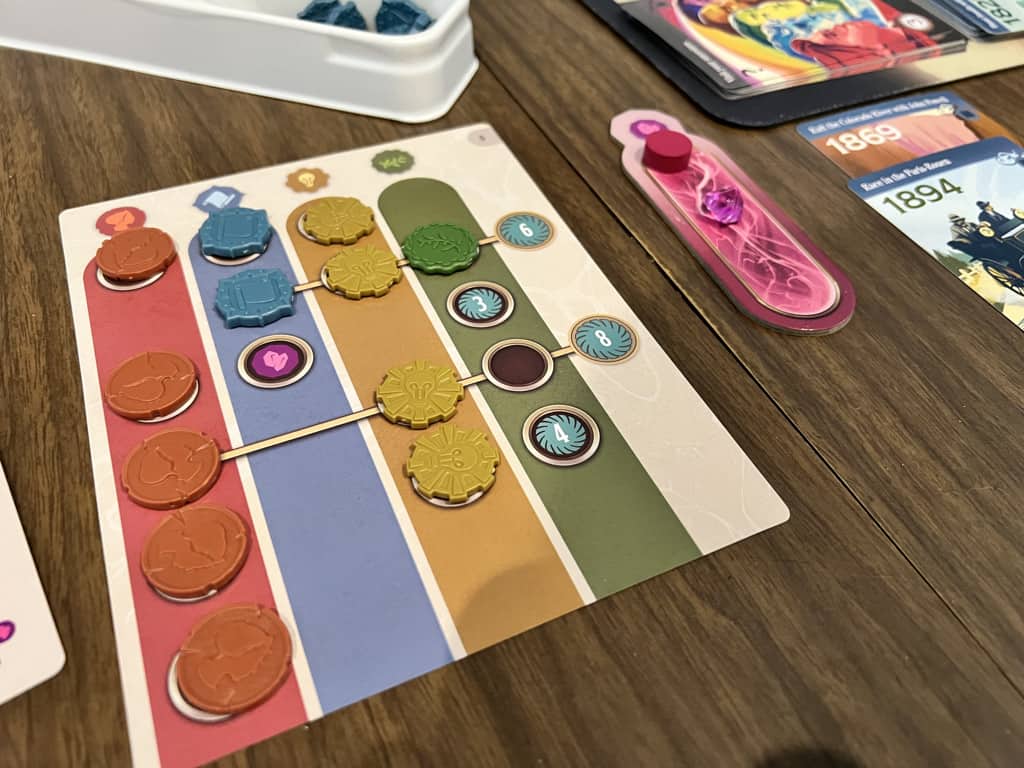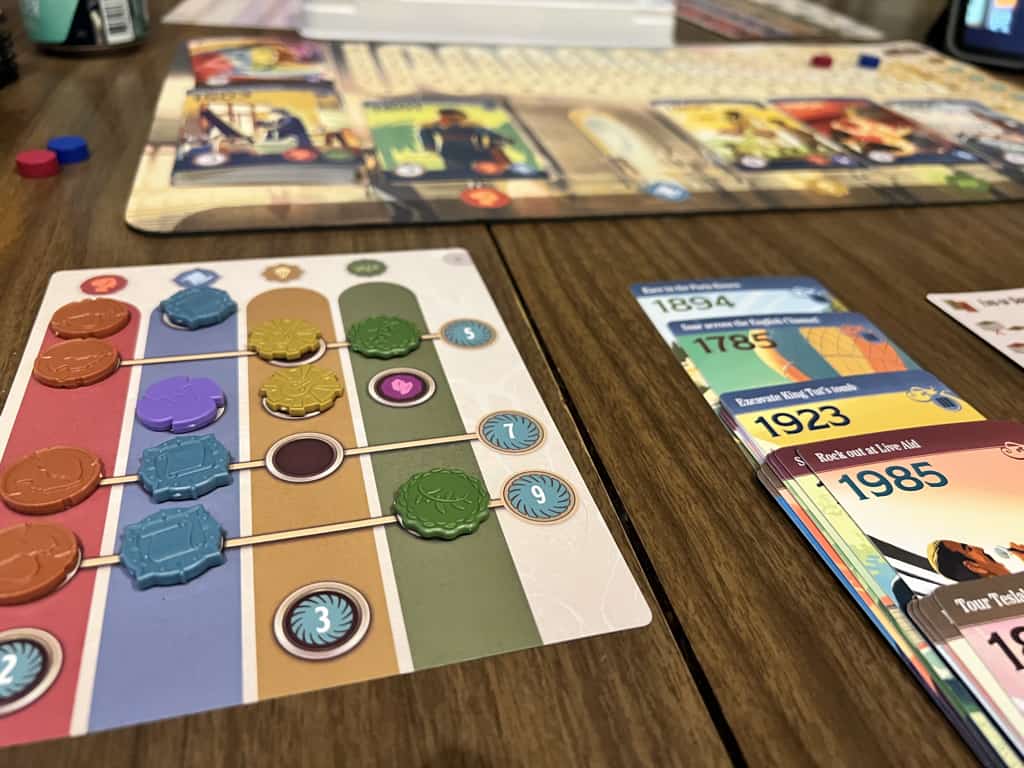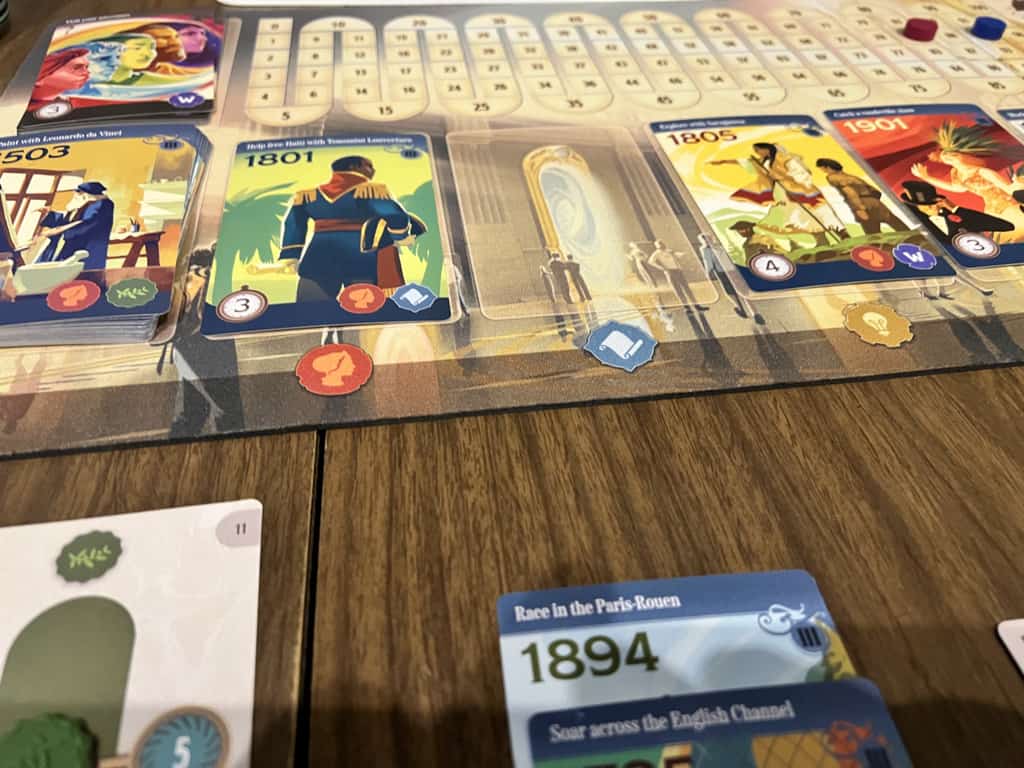(Note: We were provided a review copy of Trekking through History by the publisher, Underdog Games)
TV used to be sacred. Saturday morning, we’d wake up, binge on five hours of mindless cartoons, and then wait to see which of our favorite movies (mostly of the 1980s) would be featured that afternoon. Sometimes it was something wholly inappropriate, edited to be palatable (e.g., Revenge of the Nerds or Meatballs), but every few weeks, the local stations would pony up for one of the big hitters. Star Wars. Indiana Jones. Back to the Future.
I’ve made no secret of my life for the former, but my favorite of the bunch was probably Back to the Future, not just because it’s a brilliantly paced and plotted movie, but because I could see myself in the same situation, navigating time to save myself and my family. But I always wanted to see Marty further back in time. Give me Doc and Marty meeting Genghis Khan or sailing alongside Cleopatra. Bill & Ted would eventually scratch some of that itch, but I’ve always felt time travel movies have missed a trick, avoiding a broad swath of history that would be an absolute blast to recreate in quick two-three minute chunks.
That’s why a game like Trekking through History immediately caught my attention. The premise is simple. Players are time travelers who go on tours of history, traveling as far back as they like and then jumping forward epoch by epoch to witness incredible moments in human history. Of course, much like Doc and Marty, time travel isn’t exactly easy. It takes resources, and once back in time, you can only move in one direction, forward. So players are asked to plan efficient journeys, getting to as many sites as possible while collecting resources that reflect what they learn on those journeys.
Normally, a game like Trekking through History would earn a raised eyebrow from me, the mechanics as thinly disguised as they are, but in this case, they work seamlessly with the theme in a way that captures the imagination of children and older family members alike.
How Trekking Through History Plays
If you prefer the audio, I give my review on our most recent episode as well. Trekking through History, like its predecessors—Trekking the National Parks and Trekking the World—is a simple game. You can teach the rules in less than five minutes, and everything you really need to know is printed on two reference cards available in the box. And somewhat like those games, but more so, History integrates a degree of strategy and consideration that isn’t always present in family games of this weight, making for a thoroughly satisfying puzzle.

The game is played over three Days. Each day is represented by a deck, and the decks overlap historical dates while progressing. Day 1 has a lot of BCE events while Day 3 only has 1, but it is possible to find variable dates across all three. Players will be given itinerary sheets, one for each round (day) of the game, on which are printed different symbols—persona, event, innovation, progress, and wild. There are limited numbers of each token based on how frequently they appear in the game, and proper placement on your itineraries will yield rewards in the form of points and time crystals (more on those in a moment).
On your turn, you’ll choose one card from a tableau of six. Cards represent specific historical events dating back to 37,000 BCE and up to 1994. You’ll then place the card in your tableau. If it takes place after the most recent card in your timeline, you’ll grow that timeline. If it happens before, you’ll start a new timeline, closing the other one out for later scoring. You then gain the tokens shown on the card, placing them on your itinerary and scoring any points.
Once done, you’ll move your pocket watch on a clock track forward as many spaces as indicated on the card you took. Each card will have an amount of time between 1 and 5. You can reduce the value by spending time crystals and give yourself more potential turns during one rotation of the clock. Once you reach 12 on the clock, however, your Day is done, and you wait for the next round, so choose wisely. At any time, you can choose an Ancestor card instead of a timeline card. These act as wilds, giving you a wild resource and a wild year so you don’t have to close your timeline. Have a killer streak going that’s worth a bunch of points but the card market is terrible? Ancestor card it is.
You’ll do this until all players have reached 12, reset the deck with the next day, clear your itinerary, and set out a new one. After three days, you count up the scores and crown a winner. Front to back, it takes about an hour (even with impatient children), and it’s an absolute blast.
What’s So Good About Trekking Through History?
I enjoyed Underdog and Bink’s earlier games. They were fun, simple, highly produced games that offered a bit of education, a pretty interface, and simple mechanics, but they weren’t the kinds of puzzles I could sit and noodle over alone or with other gamers. They were family games, through and through. That’s not bad. I gave both games a Play and enjoy playing both with my family. But Trekking Through History goes above and beyond for several reasons.

First, the game has an exceptional production. From the neoprene mat to the plastic tokens, the game is aesthetically and tactilely amazing. And that’s not even taking into account the spectacular artwork on the 108 history cards. Presented in the style of classic travel posters, there are a half dozen of these cards that I’d love to have as posters for my wall, the neo-classical display of the construction of the Great Wall or Neil Armstrong landing on the moon jumping off the cards. BGG lists only one artist—Eric Hibbeler, who also worked on My Father’s Work, Junk Orbit, and The Goonies Never Say Die in recent releases. I would not be surprised to see Hibbeler picking up much more work following his efforts here.
It’s not just the look of the game that works, though. Trekking Through History is fun because it goes beyond simply collecting cards. Using the Itinerary to guide decisions about which cards are most valuable—is it the one that extends your timeline or helps you reach a combo on your itinerary—is fantastic. I had a lengthy conversation with my son about determining which action would be most beneficial by determining the value of it and future actions (negative points are a thing if you’re not careful).
The fact that it plays quickly, is accessible to all ages, is educational (with lengthy blurbs on the back of each card), and stunning to look at makes this a five-star production through and through.
Anything Not to Like?
Honestly, not really. Speaking to my children, who I trust to identify what does and doesn’t work, my son wasn’t a huge fan of the randomness of the card deck. Several times he was impacted by a poor card layout for his tableau, and while ancestor cards are useful for patching long timelines later in the game, it’s tough to burn a turn on taking one when you only have two or three cards in a set. I tend to agree with him. He also found the time crystals a tacked-on element that benefits people who draw itineraries that produce them and those with lots of 1 and 2-cost cards in play.
These are legitimate concerns. The game is somewhat random because it relies on decks of cards, but that luck is mitigated with the cards being split into three decks and the use of the ancestor cards. And for what it’s worth, I love that kind of questionable display, requiring me to think ahead and plan accordingly. The game also comes with a sheet that shows you everything that’s in the decks so you can plan accordingly. Is it smart to take that 1932 card? Well, in round two, there are only four cards that come after it, so maybe not.
The Bottom Line
Trekking Through History is a beautiful game. It’s a blast to play. And it evoked strong feelings from both of my children, which is always a good sign. For history buffs, it’s a blast to see diverse, multicultural historical representation (though it does still lean a bit heavily on European and American history), and the artwork is to die for. Bink has been refining his work throughout this trilogy of Trekking games, and this is the best of the bunch by a healthy margin. If you like the other two games, want a fun history game for the family, or are looking for a new puzzle game that takes less than an hour and offers ample replayability (I didn’t even mention the Time Warp Expansion that comes in the box or the solo mode), you owe it to yourself to check out Trekking through History. An absolute buy.
SUMMARY & RESULTS
9.0
Trekking Through History is a tightly designed, beautifully illustrated family game





Show Comments